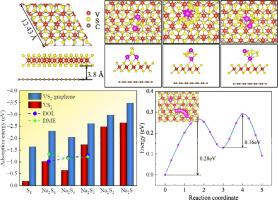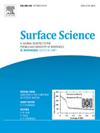VS2/graphene heterostructures as cathode materials for sodium-sulfur batteries: A first-principles study
IF 2.1
4区 化学
Q3 CHEMISTRY, PHYSICAL
引用次数: 0
Abstract
Sodium-sulfur batteries have garnered significant attention recently due to their high energy density. Nevertheless, the dissolution of sodium polysulfides in the electrolyte results in the shuttle effect, severely impacting the cycling efficiency of these batteries and limiting their widespread application. In this study, a novel two-dimensional VS2/ graphene heterostructure was designed. This material is used as an anchoring material for the anode of sodium-sulfur battery to suppress the shuttle effect. This van der Waals heterostructure is composed of graphene and VS2 stacked, and retains their inherent electronic structures. Graphene not only enhances the conductivity of sulfur cathode, but also improves the polarity of VS2 thin film. Adsorption simulations of sodium polysulfide showed that the VS2/graphene heterostructures possessed suitable adsorption energies in the range of 1.63 ∼ 3.47 eV, which were able to effectively anchor the polysulfide. In addition, the lower Na2S decomposition energy barriers and sodium ion migration energy barriers show the potential of the heterostructures in catalyzing the reaction kinetics. Therefore, the VS2/graphene heterostructure is anticipated to be an optimal anchoring material for sodium-sulfur batteries.

作为钠硫电池阴极材料的 VS2/石墨烯异质结构:第一原理研究
由于能量密度高,钠硫电池近来备受关注。然而,多硫化钠在电解液中的溶解会产生穿梭效应,严重影响这些电池的循环效率,限制了它们的广泛应用。本研究设计了一种新型二维 VS2/ 石墨烯异质结构。这种材料被用作钠硫电池阳极的锚定材料,以抑制穿梭效应。这种范德华异质结构由石墨烯和 VS2 堆叠而成,并保留了它们固有的电子结构。石墨烯不仅增强了硫阴极的导电性,还改善了 VS2 薄膜的极性。多硫化钠的吸附模拟显示,VS2/石墨烯异质结构具有合适的吸附能,范围在 1.63 ∼ 3.47 eV 之间,能够有效地锚定多硫化钠。此外,较低的 Na2S 分解能垒和钠离子迁移能垒显示了异质结构在催化反应动力学方面的潜力。因此,VS2/石墨烯异质结构有望成为钠硫电池的最佳锚定材料。
本文章由计算机程序翻译,如有差异,请以英文原文为准。
求助全文
约1分钟内获得全文
求助全文
来源期刊

Surface Science
化学-物理:凝聚态物理
CiteScore
3.30
自引率
5.30%
发文量
137
审稿时长
25 days
期刊介绍:
Surface Science is devoted to elucidating the fundamental aspects of chemistry and physics occurring at a wide range of surfaces and interfaces and to disseminating this knowledge fast. The journal welcomes a broad spectrum of topics, including but not limited to:
• model systems (e.g. in Ultra High Vacuum) under well-controlled reactive conditions
• nanoscale science and engineering, including manipulation of matter at the atomic/molecular scale and assembly phenomena
• reactivity of surfaces as related to various applied areas including heterogeneous catalysis, chemistry at electrified interfaces, and semiconductors functionalization
• phenomena at interfaces relevant to energy storage and conversion, and fuels production and utilization
• surface reactivity for environmental protection and pollution remediation
• interactions at surfaces of soft matter, including polymers and biomaterials.
Both experimental and theoretical work, including modeling, is within the scope of the journal. Work published in Surface Science reaches a wide readership, from chemistry and physics to biology and materials science and engineering, providing an excellent forum for cross-fertilization of ideas and broad dissemination of scientific discoveries.
 求助内容:
求助内容: 应助结果提醒方式:
应助结果提醒方式:


